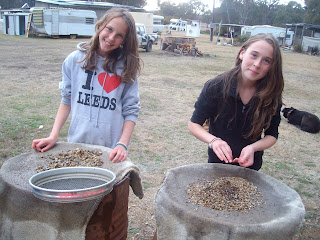So we found somewhere to park the campervan, and dashed into Church (feeling scruffy and unkempt), getting in at 8.40.
The elderly priest was half way through the sermon - which surprised us - but we then realised this was a priest who likes things done quickly. He spoke so fast, that the congregation could not keep up with him (especially as they are using a new order of mass in Australia which congregation's are still getting used to). There was no music, and we were out of there by 9.15am. The priest was clearly old fashioned - he just disappeared (most go to the back of the church to meet and greet!)
From there we went to the excellent tourist centre for orientation (and to use the loos, and to get warm!). Glen Innes is over 1,200 metres up (although flat farming land) - - that's close to 4000 feet and it was chilly when the sun was not around
Glenn Innes has badged itself as a Celtic town (and actually you can see why) - although the architecture is a bit more wild west - with huge streets (so that a bullock and cart can be turned around). The town hall is decked with Scottish, Irish, Cornish and Breton flags!
First stop was their recreation of stone henge - and other standing stones (where they celebrate the solstice) - to be honest this did not do too much for us!.
Then it was a shop for provisions, and we drove 12 k down a dirt road to a farmstead which does fossicking. The area is rich in gems - there was a gold rush here, and also sapphire mines. The river beds can be panned for sapphires, and apparently lots of people still do this. We spent an hour or so fossicking on the farmstead - with their fantastic dogs (it was reasonable value at £15 for the whole family) - and we found some small sapphires to bring back to the UK. When we started
the sun was out (which is needed to better identify gems), but it was cold in the water when washing rocks. Then it clouded over - and quickly came cool at this altitude - to be followed by lightening and clashes of thunder and rain - so we were ready to finish when we did!
Glenn Innes is predominately cattle and sheep country, but we also passed a number of vineyards (avoiding the temptation to stop at any), just a 100 or so Km further south in the start of the Hunter Valley, which produces most of New South Wales wines.
We really were not sure where we would be camping that evening, but set off for the waterfall way - basically back across the great dividing range - which meant going up to 1,500 metres before dropping back down to the sea. The area is peppered with waterfalls. Much of the area was once a huge volcano, and is now a mountainous area - mainly National Parks, volcanic rocks and deep gorges - with surviving rain forest - much like the Springbrook National Park we visited before Byron Bay.
It rained hard a few times - real sunshine and showers. On the way to Ebor - our planned destination we passed a crashed car, and then shortly after another one. It transpired that there had been a massive hail storm that afternoon, which had turned the road into sheet ice, (we could see the hail still on the sides of the road) - hence two cars over turning (drivers not badly injured) - so we were pleased we were not driving through earlier. A salutary lesson, as Jim was driving quite fast to try to get to a National Park campsite before dark.
As it was we arrived at a (free) campsite at the New England National Park (1,500 metres) just as it was getting dark. This time we got out to survey the ground before driving on it. It was cold - and only 2 other brave campers there.
On the way we saw loads of Kangaroos, rabbits and massive hares (as well as the colourful parrots etc).
It was a cold night!
Glen Innes Stonehenge (things mayor's do in an attempt to put their town on the map!)
Liz seeking her fortune
Girls fossicking
Joseph finds some friends
Eating in (far too cold to eat outside the van tonight!)





No comments:
Post a Comment